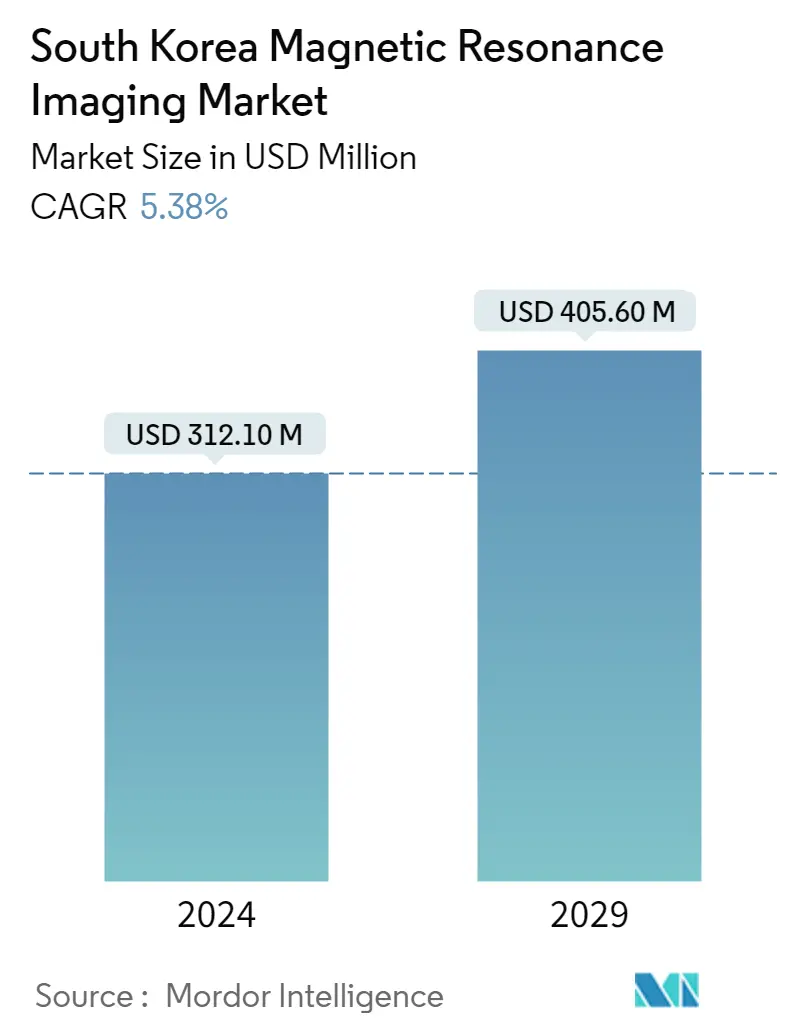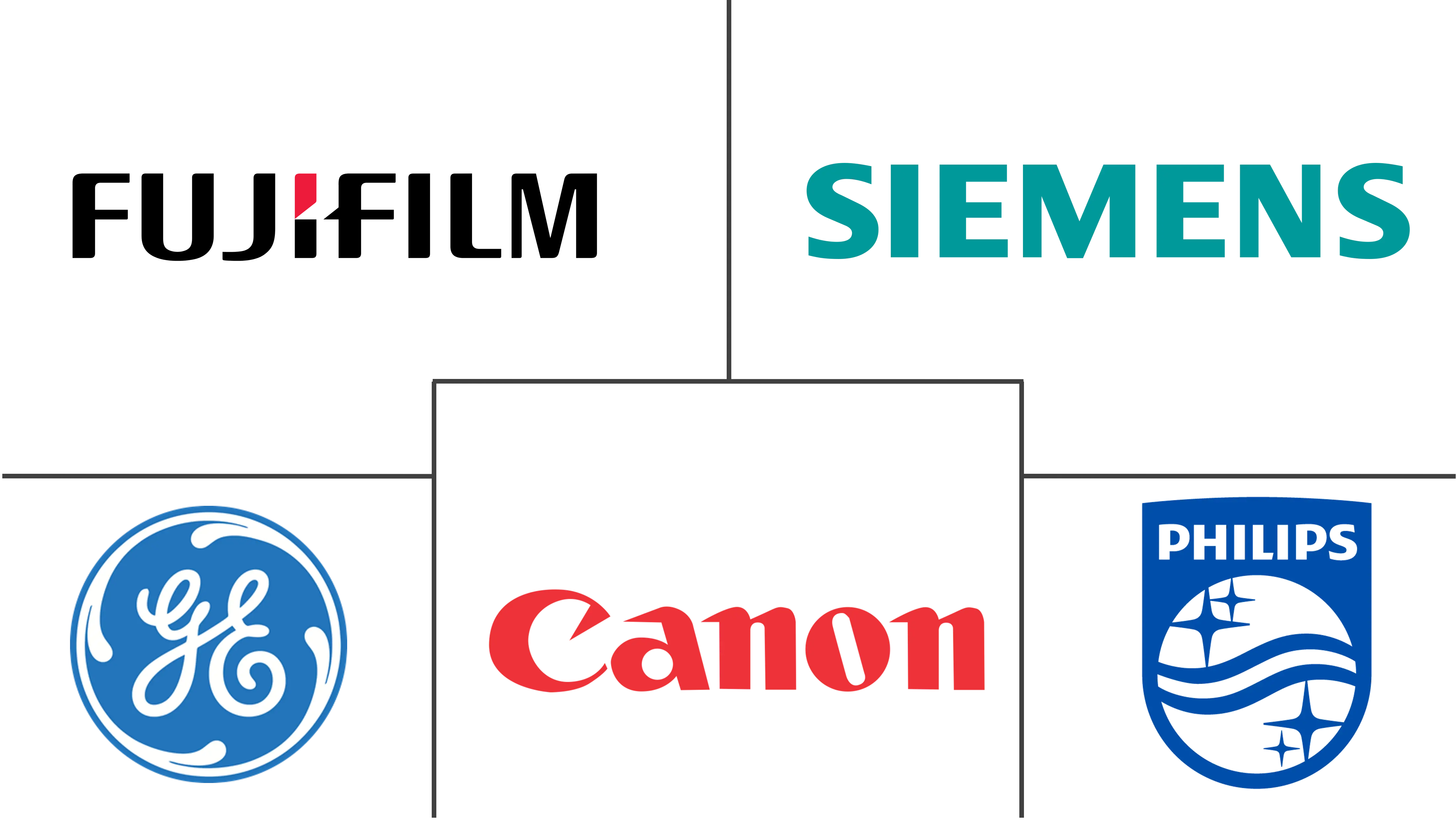Market Size of South Korea Magnetic Resonance Imaging Industry

| Study Period | 2019 - 2029 |
| Base Year For Estimation | 2023 |
| Market Size (2024) | USD 312.10 Million |
| Market Size (2029) | USD 405.60 Million |
| CAGR (2024 - 2029) | 5.38 % |
| Market Concentration | Medium |
Major Players
*Disclaimer: Major Players sorted in no particular order |
South Korea Magnetic Resonance Imaging Market Analysis
The South Korea Magnetic Resonance Imaging Market size is estimated at USD 312.10 million in 2024, and is expected to reach USD 405.60 million by 2029, growing at a CAGR of 5.38% during the forecast period (2024-2029).
The COVID-19 pandemic affected the market studied severely which was majorly due to the restrictions on non-emergency diagnostic procedures as a preventive major of coronavirus infection. As per an article published in March 2021, 'A critical juncture in universal healthcare: insights from South Korea's COVID-19 experience for the United Kingdom to consider,' the South Korean universal healthcare system, in particular, has been praised for its achievement in flattening the curve of confirmed COVID-19 cases. However, the pandemic has created stressful situations in the initial times. It created many adverse complications in patients. In some places, the lack of healthcare facilities caused difficulties in getting the right therapy. An MRI scan is used to track the progression of COVID-19 symptoms. Neurologic manifestations of COVID-19 are associated with MRI scans of abnormal brains and symptoms of anosmia, partial loss of sense of smell, or changes in taste in a patient with a severe case of COVID-19. Likewise, there are many effects associated with COVID-19 infection reviewed theoretically and practically. Most of them needed MRI imaging to identify the possible changes. Hence, with the use of MRI in South Korea in understanding the adverse effects of COVID-19 on other organs, the market studied was witnessing a gradual rate of growth during the years 2020 and 2021. However, the market is gaining pace currently as there has been a surge in elective diagnostics or procedures.
The major factors that are expected to drive the growth of the magnetic resonance imaging (MRI) market in South Korea include the presence of a large geriatric population, advanced healthcare infrastructure, and new product launches in the country. Furthermore, increasing prevalence and burden of chronic diseases is fueling the market growth in South Korea. For instance, As per the article titled 'Health-economic burden of dementia in South Korea' published by BMC in October 2021, the prevalence of dementia in Korea in the year 2020 was 10.25% among those aged 65 and above which accounted for around 8,30,000 people. It is anticipated to rise to nearly 15.91% by 2050, with a population of 3.02 million suffering from dementia. Thus, increasing cases of dementia in the future will create the demand for MRI scans in the country and will contribute to the market growth.
South Korea Magnetic Resonance Imaging Industry Segmentation
As per the scope of this report, Magnetic resonance imaging is a medical imaging technique, which is used in radiology to produce pictures of the anatomy and the physiological processes of the body. These pictures are further used to diagnose and detect the presence of abnormalities in the body. South Korea Magnetic Resonance Imaging (MRI) Market is segmented by Architecture (Closed MRI Systems and Open MRI Systems), Field Strength (Low Field MRI Systems, High Field MRI Systems, Very High Field MRI Systems, and Ultra-high MRI Systems), Application (Oncology, Neurology, Cardiology, Gastroenterology, Musculoskeletal, and Other Applications). The report offers the value (in USD million) for the above segments.
| By Architecture | |
| Closed MRI Systems | |
| Open MRI Systems |
| By Field Strength | |
| Low Field MRI Systems | |
| High Field MRI Systems | |
| Very High Field MRI Systems and Ultra-high MRI Systems |
| By Application | |
| Oncology | |
| Neurology | |
| Cardiology | |
| Gastroenterology | |
| Musculoskeletal | |
| Other Applications |
South Korea Magnetic Resonance Imaging Market Size Summary
The magnetic resonance imaging (MRI) market in South Korea is poised for significant growth over the forecast period, driven by a combination of demographic, technological, and healthcare infrastructure factors. The presence of a large geriatric population and the increasing prevalence of chronic diseases, such as dementia, are key contributors to the rising demand for MRI scans. The advanced healthcare infrastructure in South Korea, coupled with new product launches and technological advancements in high-field MRI scanners, is further propelling market expansion. The COVID-19 pandemic initially impacted the market due to restrictions on non-emergency procedures, but the use of MRI in understanding the virus's effects on patients has contributed to a gradual recovery and growth in the market.
The competitive landscape of the South Korean MRI market is characterized by the dominance of major players like Siemens Healthineers, GE Healthcare, Canon Medical Systems, and Philips Healthcare. However, mid-size to smaller companies are gaining traction by introducing innovative products at competitive prices. Technological advancements, such as the development of AI-powered MRI software by local startups, are enhancing the capabilities and efficiency of MRI systems, thereby driving market growth. The rising adoption of high-field MRI scanners, supported by strategic product launches and investments, is expected to further bolster the market's expansion in the coming years.
South Korea Magnetic Resonance Imaging Market Size - Table of Contents
-
1. MARKET DYNAMICS
-
1.1 Market Overview
-
1.2 Market Drivers
-
1.2.1 Introduction of Hybrid MRI Systems
-
1.2.2 Increasing Prevalence of Chronic Diseases and Rising Geriatric Population
-
-
1.3 Market Restraints
-
1.3.1 High Cost of MRI Systems
-
-
1.4 Porter's Five Forces Analysis
-
1.4.1 Threat of New Entrants
-
1.4.2 Bargaining Power of Buyers/Consumers
-
1.4.3 Bargaining Power of Suppliers
-
1.4.4 Threat of Substitute Products
-
1.4.5 Intensity of Competitive Rivalry
-
-
-
2. MARKET SEGMENTATION (Market Size by Value - USD million)
-
2.1 By Architecture
-
2.1.1 Closed MRI Systems
-
2.1.2 Open MRI Systems
-
-
2.2 By Field Strength
-
2.2.1 Low Field MRI Systems
-
2.2.2 High Field MRI Systems
-
2.2.3 Very High Field MRI Systems and Ultra-high MRI Systems
-
-
2.3 By Application
-
2.3.1 Oncology
-
2.3.2 Neurology
-
2.3.3 Cardiology
-
2.3.4 Gastroenterology
-
2.3.5 Musculoskeletal
-
2.3.6 Other Applications
-
-
South Korea Magnetic Resonance Imaging Market Size FAQs
How big is the South Korea Magnetic Resonance Imaging Market?
The South Korea Magnetic Resonance Imaging Market size is expected to reach USD 312.10 million in 2024 and grow at a CAGR of 5.38% to reach USD 405.60 million by 2029.
What is the current South Korea Magnetic Resonance Imaging Market size?
In 2024, the South Korea Magnetic Resonance Imaging Market size is expected to reach USD 312.10 million.

